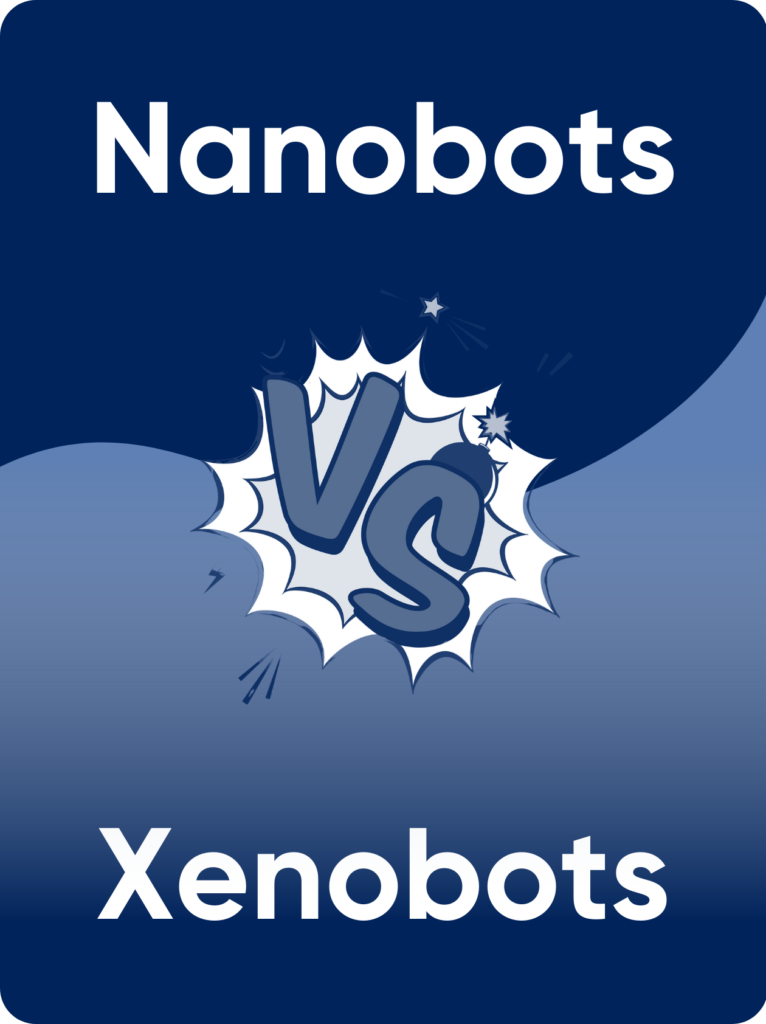
15/08/2023
Biotechnology
Nanobots, Xenobots, what do they have in common? The debate between Nanobots and Xenobots is a critical one. Nanobots and Xenobots are significant developments within the life science industry.
Welcome to the microscopic arena. Featuring tiny titans – Nanobots vs Xenobots! These pint-sized powerhouses are revolutionizing the way we view science and technology. Let’s dive into this debate to see whether Xenobots or Nanobots will have the biggest impact.
Nanobots: Nano Hero’s
Meet the Nanobots. These minuscule machines could give ants a run for their money in the size department!
Nanobots are nano-scale robots. They are designed to perform a wide array of tasks. These range from within the human body, industries, and even the environment. Picture them as the fantastical voyagers of the nanoscale. They navigate through blood vessels and repair damaged cells with astonishing precision. These ingenious creations are unlocking new frontiers in medicine and biotechnology. They are making the impossible seem ordinary.
If Nanobots interest you, you can learn more about them here.
Xenobots: Nature’s Genetic Marvels
Who are these enigmatic competitors? Xenobots are not your ordinary robots. While Nanobots are made of synthetic materials, Xenobots are biological. They are living organisms, custom-designed by scientists and AI. They were developed through the cutting-edge field of synthetic biology.
Scientists developed Xenobots from frog cells. Xenobots harness the inherent self-organization and regeneration of cells. These living machines pave the way for a new era of biological engineering.
Clash of the Titans: Nanobots vs Xenobots
Nanobots and Xenobots exhibit striking similarities and fascinating differences. Nanobots are engineered to perfection, with the precision of a Swiss watch. Alternatively, Xenobots embrace the unpredictable beauty of living organisms.
In more practical terms; a Xenobot could be developed from a patient’s very own cells. This means that while in the body, our immune system would not attack a Xenobot. Xenobots would be virtually undetectable as a foreign entrant. This means building our personalised fighters, keeping our bodies healthy. This isn’t the only application xenobots have. In fact, they could also:
- Unpollute our oceans
- Unclog arteries
- Clean radioactive waste
Nanobots have already proven their worth in targeted drug delivery. They are opening up new possibilities for cancer treatment and other diseases. Xenobots show promise in a variety of areas:
- environmental clean-up
- removing toxins
- reassembling tissue for regenerative medicine
This is completely different to Nanobots that are made of metals and other foreign materials. Nanobots also have incredible future applications. Nanobots could do all of the same things, but their functioning would be different. Xenobots function unpredictably. Afterall, they are biological robots. Xenobots demonstrate emergent behaviour. Nanobots (most likely) wouldn’t display emergent behaviour. This is because nanobots would be programmed and controllable.
Emergent behaviour from Xenobots acts as a threat. Alternatively, Nanobots’ very materials threaten their abilities to safely navigate our bodies.
The Ethical Dilemma: Friends or Foes?
We can’t ignore the elephant-sized ethical questions in the room. Are these microscopic creations beneficial, or do they hold unforeseen dangers? There are concerns about nanobots being rejected by our bodies. This could be catastrophic if the nanobot is delivering medicine or surgery to a patient’s body.
Xenobots out-competing native species in ecosystems loom large. However, Xenobots today can not survive outside of highly controlled conditions. But fear not! Scientists, ethicists, and policymakers are collaborating. They endeavour to ensure these marvels remain forces for good.
Conclusion
The debate over whether Xenobots or Nanobots will have the biggest impact is ongoing. Both technologies have incredible potential. But they also come with their own set of challenges. Nanobots are more predictable and controllable, but our bodies might reject them. Xenobots are more unpredictable, but they are also more compatible with our bodies.
The future of these two technologies depends on how we address ethical concerns. If we can do that, then these microscopic marvels could revolutionize the way we live and work.
Here are some additional thoughts on the future of Xenobots and Nanobots:
- Nanobots could be used to clean up pollution and other environmental problems.
- Both Xenobots and Nanobots could be used to develop new forms of biotechnology, such as artificial organs and tissues.
The possibilities are endless. It is important to remember that these technologies are in their early stages. We need to be careful about how we use them so that they do not pose a threat to our health or safety.
However, these technologies have the potential to make the world a better place.








